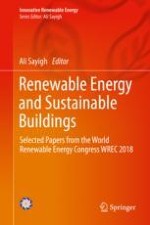2020 | OriginalPaper | Chapter
26. Effects of Mirror Geometry on the Optical Efficiency of a Linear Fresnel Reflector (LFR)
Authors : M. P. G. Sirimanna, J. D. Nixon
Published in: Renewable Energy and Sustainable Buildings
Publisher: Springer International Publishing
Activate our intelligent search to find suitable subject content or patents.
Select sections of text to find matching patents with Artificial Intelligence. powered by
Select sections of text to find additional relevant content using AI-assisted search. powered by
